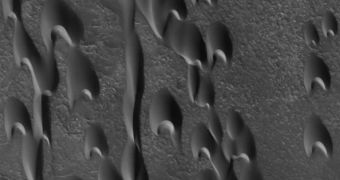Some of the most commonly known features on Mars are the planet's hills, which appear to have been shaped by winds. Astronomers and geologists argue had argued for a long time that this was the case, but it later on became obvious that atmospheric models and on-site rover measurements did not support this idea. Spirit and Opportunity showed that the wind was barely strong enough to get the sand to move in the first place, and to make it bounce. But a newly modified numerical model now proposes an alternate explanation for these landscape features, Wired reports.
The researchers that constructed it say that Martian sand grains exhibit a peculiar type of behavior, in the sense that they cannot easily stop bouncing once they get to do that. The thing is, they cannot be easily set in motion, and the wind is not strong enough to do so. “It’s like when you ride a bike: It costs a lot of exertion to get it going, but once you’re going it’s easier to keep going,” former University of Michigan in Ann Arbor student Jasper Kok, who is now an atmospheric physicist at the National Center for Atmospheric Research (NCAR), in Boulder, Colorado, says.
He is also the author of a new scientific paper detailing the conclusions drawn from the numerical model, which is scheduled for publication in an upcoming issue of the respected journal Physical Review Letters. “It’s much easier to keep this process going than it is to start it in the first place,” Kok adds. He explains that the simulation he modified took into account Martian gravity and atmosphere, but also a phenomenon called splashing. It refers to when a sand particle falling to the ground hits at least another one, forcing the second to start moving.
“That’s hard to study in a wind tunnel. [The investigation] goes numerically where we have a hard time going with wind tunnel experiments,” Cornell University planetary scientist Robert Sullivan says. According to Kok, the way in which the sand grains interact holds the key to understanding these major landscape features on the Red Planet. “This splashing process is really efficient. It can keep saltation, or sand blowing, going on Mars at relatively low wind speeds,” he says. “This study is very welcome, very informative. The results go a long way toward explaining several mysteries,” Sullivan concludes.

 14 DAY TRIAL //
14 DAY TRIAL //